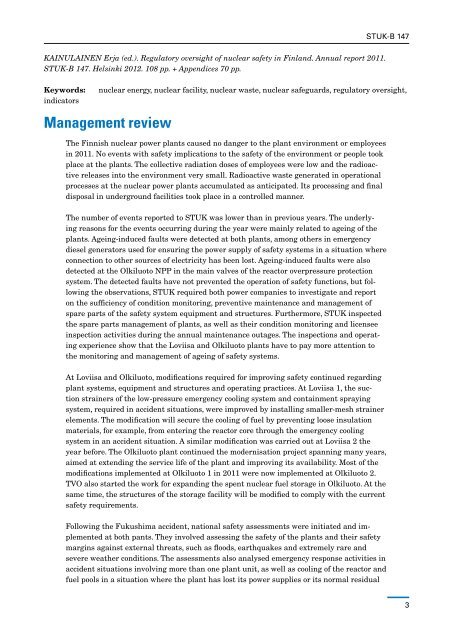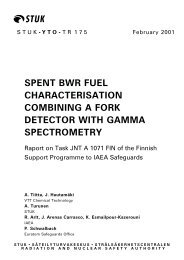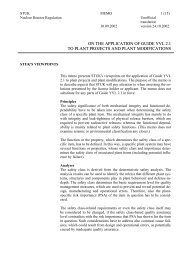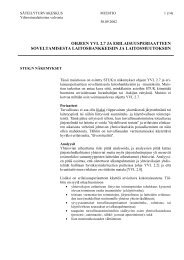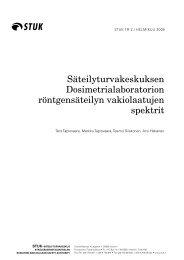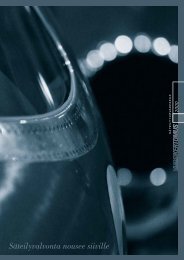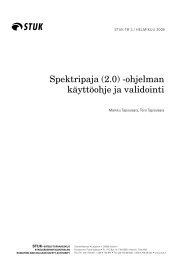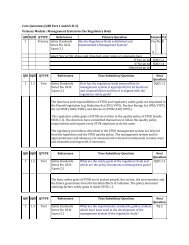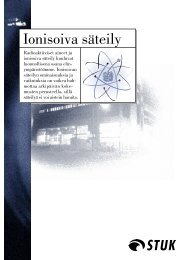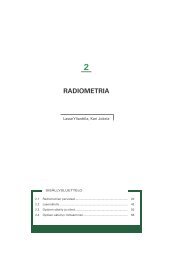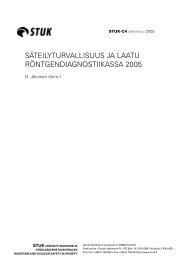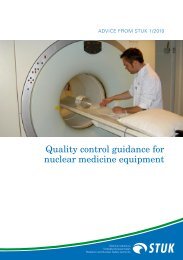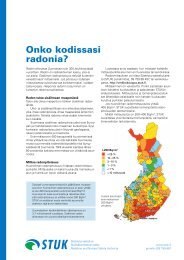Regulatory oversight of nuclear safety in Finland. Annual ... - STUK
Regulatory oversight of nuclear safety in Finland. Annual ... - STUK
Regulatory oversight of nuclear safety in Finland. Annual ... - STUK
You also want an ePaper? Increase the reach of your titles
YUMPU automatically turns print PDFs into web optimized ePapers that Google loves.
KAINULAINEN Erja (ed.). <strong>Regulatory</strong> <strong>oversight</strong> <strong>of</strong> <strong>nuclear</strong> <strong>safety</strong> <strong>in</strong> F<strong>in</strong>land. <strong>Annual</strong> report 2011.<br />
<strong>STUK</strong>-B 147. Hels<strong>in</strong>ki 2012. 108 pp. + Appendices 70 pp.<br />
Management review<br />
The F<strong>in</strong>nish <strong>nuclear</strong> power plants caused no danger to the plant environment or employees<br />
<strong>in</strong> 2011. No events with <strong>safety</strong> implications to the <strong>safety</strong> <strong>of</strong> the environment or people took<br />
place at the plants. The collective radiation doses <strong>of</strong> employees were low and the radioactive<br />
releases <strong>in</strong>to the environment very small. Radioactive waste generated <strong>in</strong> operational<br />
processes at the <strong>nuclear</strong> power plants accumulated as anticipated. Its process<strong>in</strong>g and f<strong>in</strong>al<br />
disposal <strong>in</strong> underground facilities took place <strong>in</strong> a controlled manner.<br />
<strong>STUK</strong>-B 147<br />
Keywords: <strong>nuclear</strong> energy, <strong>nuclear</strong> facility, <strong>nuclear</strong> waste, <strong>nuclear</strong> safeguards, regulatory <strong>oversight</strong>,<br />
<strong>in</strong>dicators<br />
The number <strong>of</strong> events reported to <strong>STUK</strong> was lower than <strong>in</strong> previous years. The underly<strong>in</strong>g<br />
reasons for the events occurr<strong>in</strong>g dur<strong>in</strong>g the year were ma<strong>in</strong>ly related to age<strong>in</strong>g <strong>of</strong> the<br />
plants. Age<strong>in</strong>g-<strong>in</strong>duced faults were detected at both plants, among others <strong>in</strong> emergency<br />
diesel generators used for ensur<strong>in</strong>g the power supply <strong>of</strong> <strong>safety</strong> systems <strong>in</strong> a situation where<br />
connection to other sources <strong>of</strong> electricity has been lost. Age<strong>in</strong>g-<strong>in</strong>duced faults were also<br />
detected at the Olkiluoto NPP <strong>in</strong> the ma<strong>in</strong> valves <strong>of</strong> the reactor overpressure protection<br />
system. The detected faults have not prevented the operation <strong>of</strong> <strong>safety</strong> functions, but follow<strong>in</strong>g<br />
the observations, <strong>STUK</strong> required both power companies to <strong>in</strong>vestigate and report<br />
on the sufficiency <strong>of</strong> condition monitor<strong>in</strong>g, preventive ma<strong>in</strong>tenance and management <strong>of</strong><br />
spare parts <strong>of</strong> the <strong>safety</strong> system equipment and structures. Furthermore, <strong>STUK</strong> <strong>in</strong>spected<br />
the spare parts management <strong>of</strong> plants, as well as their condition monitor<strong>in</strong>g and licensee<br />
<strong>in</strong>spection activities dur<strong>in</strong>g the annual ma<strong>in</strong>tenance outages. The <strong>in</strong>spections and operat<strong>in</strong>g<br />
experience show that the Loviisa and Olkiluoto plants have to pay more attention to<br />
the monitor<strong>in</strong>g and management <strong>of</strong> age<strong>in</strong>g <strong>of</strong> <strong>safety</strong> systems.<br />
At Loviisa and Olkiluoto, modifications required for improv<strong>in</strong>g <strong>safety</strong> cont<strong>in</strong>ued regard<strong>in</strong>g<br />
plant systems, equipment and structures and operat<strong>in</strong>g practices. At Loviisa 1, the suction<br />
stra<strong>in</strong>ers <strong>of</strong> the low-pressure emergency cool<strong>in</strong>g system and conta<strong>in</strong>ment spray<strong>in</strong>g<br />
system, required <strong>in</strong> accident situations, were improved by <strong>in</strong>stall<strong>in</strong>g smaller-mesh stra<strong>in</strong>er<br />
elements. The modification will secure the cool<strong>in</strong>g <strong>of</strong> fuel by prevent<strong>in</strong>g loose <strong>in</strong>sulation<br />
materials, for example, from enter<strong>in</strong>g the reactor core through the emergency cool<strong>in</strong>g<br />
system <strong>in</strong> an accident situation. A similar modification was carried out at Loviisa 2 the<br />
year before. The Olkiluoto plant cont<strong>in</strong>ued the modernisation project spann<strong>in</strong>g many years,<br />
aimed at extend<strong>in</strong>g the service life <strong>of</strong> the plant and improv<strong>in</strong>g its availability. Most <strong>of</strong> the<br />
modifications implemented at Olkiluoto 1 <strong>in</strong> 2011 were now implemented at Olkiluoto 2.<br />
TVO also started the work for expand<strong>in</strong>g the spent <strong>nuclear</strong> fuel storage <strong>in</strong> Olkiluoto. At the<br />
same time, the structures <strong>of</strong> the storage facility will be modified to comply with the current<br />
<strong>safety</strong> requirements.<br />
Follow<strong>in</strong>g the Fukushima accident, national <strong>safety</strong> assessments were <strong>in</strong>itiated and implemented<br />
at both pants. They <strong>in</strong>volved assess<strong>in</strong>g the <strong>safety</strong> <strong>of</strong> the plants and their <strong>safety</strong><br />
marg<strong>in</strong>s aga<strong>in</strong>st external threats, such as floods, earthquakes and extremely rare and<br />
severe weather conditions. The assessments also analysed emergency response activities <strong>in</strong><br />
accident situations <strong>in</strong>volv<strong>in</strong>g more than one plant unit, as well as cool<strong>in</strong>g <strong>of</strong> the reactor and<br />
fuel pools <strong>in</strong> a situation where the plant has lost its power supplies or its normal residual<br />
3


